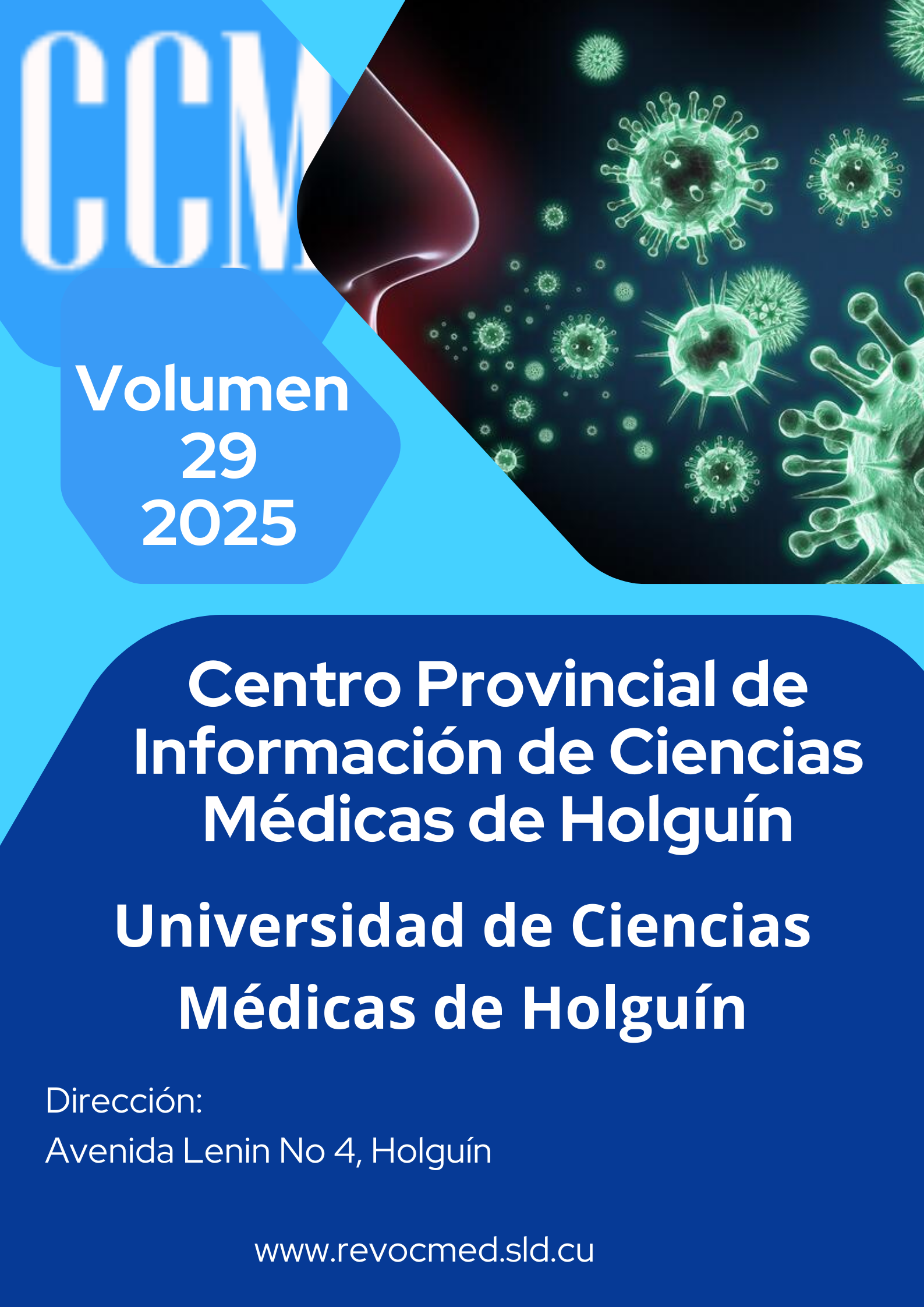Weight of newborns according to gestation time and maternal ages: Covid-19 pre-pandemic and post-pandemic
Keywords:
peso al nacer, peso insuficiente, peso promedio, recién nacidoAbstract
Introduction: During the pandemic, social crises have an unfavorable effect on the weight of newborns. This research establishes the difference in this indicator between the pre and post-pandemic stages.
Objective: To determine the effects on the weight of newborns according to gestational age and maternal age in the pre-pandemic stage and in children born to vaccinated mothers who did not suffer the disease in the post-pandemic stage.
Method: Longitudinal retrospective study in pregnant women living in Holguín province, whose deliveries occurred at Hospital Docente Universitario V. I. Lenin. Stage I includes the (NB) in the year 2019 (pre-pandemic) and stage II, the post-pandemic births of vaccinated mothers who did not suffer the disease.
Results: There was an increase in the underweight rate in stage II versus stage I. Increased underweights occurred in stage II vs. stage I. All mean weights decreased in all weeks of stage II. There was no significant difference between the small-for-age (SGA) index in both stages.
Conclusions: Unfavorable results were detected in the indicators of newborn weights according to pregnancy weeks and maternal ages in stage II. The global index of low birth weight was higher in stage II. The rate of underweight newborns was higher in all weeks of stage II.
Keywords: birth weight, insufficient weight, average weights, new born
Downloads
References
Beldarrain Chaple E, Alfonso Sánchez I, Morales Suárez I, Durán García F. Primer acercamiento histórico-epidemiológico a la COVID-19 en Cuba. Anales de la ACC.2020 [citado 22/09/2023];10(2). Disponible en: https://revistaccuba.sld.cu/index.php/revacc/article/view/862
Valdés Balbín Y, Santana Mederos D, Quintero Moreno LM, Rodríguez Noda LM ,Sánchez Ramírez B ,Pérez Nicado R, et. al. Diseño, desarrollo y evaluación preclínica de SOBERANA®02: una vacuna cubana contra COVID-19. Anales de la ACC .2023 [citado 15/10/2023];13(1):e1401. Disponible en: http://www.revistaccuba.cu/index.php/revacc/article/view/1401
Escobar Pérez ME. Cuarentena y aislamiento. Medidas de control contra la COVID-19. CCM. 2021 [citado 13/11/2023];25(4).Disponible en:
https://revcocmed.sld.cu/index.php/cocmed/article/view/4265
Portales Miranda J.A. intervención del Ministro de Salud Pública de Cuba en la Conferencia de Ministros de Salud de Iberoamérica. Redacción Minsap. Revista Infodir. 2021 [citado 13/11/2023]. Disponible en: https://revinfodir.sld.cu/index.php/infodir/article/view/1170
Benítez CE. Impactos psicosociales de la pandemia covid- 19 en la educación . Ciencia Latina.2023 [citado 06/07/2025];7(3):9604-9619. Disponible en:
https://ciencialatina.org/index.php/cienciala/article/view/6857
Ochoa Alonso A, Selva Suárez L, de Souza LE. Ciencia, salud y solidaridad para salvar vidas: un llamado a la acción contra la COVID-19. Anales de la ACC.2020 [citado 07/11/2023];10(2). Disponible en: https://revistaccuba.sld.cu/index.php/revacc/article/view/879
Aguilar Estrada OA, Anaya Herazo CA, Trujillo Ricaño M, Navarro Marín E, Sosa Leyva M. COVID-19 y uso de vacunación de emergencia en el embarazo. Rev Cuba Obstet Ginecol.2023 [citado 03/03/2025];48(2):e1131. Disponible en: https://revginecobstetricia.sld.cu/index.php/gin/article/view/362
Leiva AM, Nazar G, Martínez Sangüinetti MA, Petermann Rocha F, Ricchezza J, Celis Morales C. Dimensión Psicosocial de la Pandemia: La otra cara del Covid-19. Cienc Enferm.2020 [citado 18/03/2024];26:10. Disponible en: http://www.scielo.cl/scielo.php?script=sci_arttext&pid=S0717-95532020000100302&lng=es
Lorenzo Ruiz A, Díaz Arcaño K, Zaldívar Pérez D. La psicología como ciencia en el afrontamiento a la COVID-19: apuntes generales. Anales de la ACC .2020 [citado 18/03/2024];10(2). Disponible en: https://revistaccuba.sld.cu/index.php/revacc/article/view/839
Román Hernández JJ. La pandemia y las personas: la clave está en el riesgo. Rev Cubana Hig Epidemiol.2021[citado 08/07/2025];57. Disponible en: http://scielo.sld.cu/scielo.php?script=sci_arttext&pid=S1561-30032020000100021&lng=es
Martínez-Mahiques P, Díaz Rojas P. Curvas de crecimiento intrauterino según peso, edad gestacional y sexos. Municipio Holguín. Años 2008 al 2015. Rev Cubana de Obstetricia y Ginecología 2016 (Internet) [citado 08/04/2016];42(4). Suplemento Disponible en:
Ratowieski J, Poleta FA, Gimenez LG, Gili JA, Pawluk MS, López Camelo JS.Prevalence of low birth weight in a scenario of economic depression in Argentina. Arch Argent Pediatr. 2018 [citado 08/04/2024];116(5):322-327. Disponible en: https://www.sap.org.ar/docs/publicaciones/archivosarg/2018/v116n5a05e.pdf
Fernández Brizuela EJ, del Valle Piñera F, López Labarta L. Factores de riesgo asociados al bajo peso al nacer en un área de salud de Camagüey. Medisan.2021 [citado 08/06/2025];25(4):856-867. Disponible en: https://medisan.sld.cu/index.php/san/article/view/3662
Helga Eiríksdóttir V, Laufey Ásgeirsdóttir T, Ingibjörg Bjarnadóttir R, Kaestner R, Cnattingius S, Valdimarsdóttiret UA. Low Birth Weight, Small for Gestational Age and Preterm Births before and after the Economic Collapse in Iceland: A Population Based Cohort Study. Plos ONE. 2013 [citado 13/07/2024];8(12):e80499. Disponible en: https://journals.plos.org/plosone/article/file?id=10.1371/journal.pone.0080499&type=printable
Martínez Mahiques PA, Díaz Rojas P, Uribasterra Campos AA. Pesos promedio de recién nacidos según grupos de pesos y edades maternas en Holguín: 1993-1996, 2013-2016. CCM. 2022 [citado 08/06/2025];26(3). Disponible en: https://revcocmed.sld.cu/index.php/cocmed/article/view/4429
báñez Toda L, Grupo para el Estudio del Niño Pequeño para la Edad Gestacional de la Sociedad Española de Endocrinología Pediátrica.Pequeño para la edad gestacional: consecuencias endocrino-metabólicas. En: AEPap (ed.). Curso de Actualización Pediatría 2018. Madrid: Lúa Ediciones 3.0; 2018. p. 179-190.Disponible en: https://www.aepap.org/sites/default/files/179-190_pequeno_para_la_edad_gestacional.pdf
Martínez Mahiques PA, Díaz Rojas P, Uribasterra Campos AA. Nuevas referencias percentiladas del peso de recién nacidos según tiempo de gestación en madres adolescentes. Holguín, Cuba. CCM. 2021 [citado 08/05/2025];25(1).Disponible en: https://revcocmed.sld.cu/index.php/cocmed/article/view/3481
Ray JG, Sgro M, Mamdani MM, Glazier RH, Bocking A, Hilliard R, et al. Birthweight curves tailored to maternal world region. J Obstet Gynaecol Can. 2012[citado 30/03/2024];34(2):159-171. Disponible en: https://www.sciencedirect.com/science/article/abs/pii/S1701216316351593?via%3Dihub
Luigi Carbone L, Giuseppina Trinchillo M , Di Girolamo R , Raffone A , Saccone G, Lorio G, et al. COVID-19 vaccine and pregnancy outcomes: A systematic review and meta-analysis. Int J Gynaecol Obstet. 2022[citado 30/03/2024];159(3):651-661. Disponible en: https://pmc.ncbi.nlm.nih.gov/articles/PMC9349529/
Huacachi Trejo K, Correa López LE. Características maternas asociadas al diagnóstico de macrosomía fetal en un Hospital III-1 de la capital de Perú. Rev Faca Med Hum.2020[citado 18/04/2024];20(1)75-81. Disponible en: http://www.scielo.org.pe/scielo.php?script=sci_arttext&pid=S230805312020000100076&lng=es
Published
How to Cite
Issue
Section
License
Copyright (c) 2025 Pedro Ángel Martínez Mahiques, Elizabeth Katiuska Leyva Sánchez, Richard Garib Hernández

This work is licensed under a Creative Commons Attribution-NonCommercial 4.0 International License.
ACCESS AND DISTRIBUTION POLICY
All published articles are open access contributions, which are distributed under the terms of the Creative Commons Attribution-NonCommercial 4.0 License which permits unrestricted non-commercial use, distribution and reproduction in any medium, provided that the primary source of publication is properly cited.




